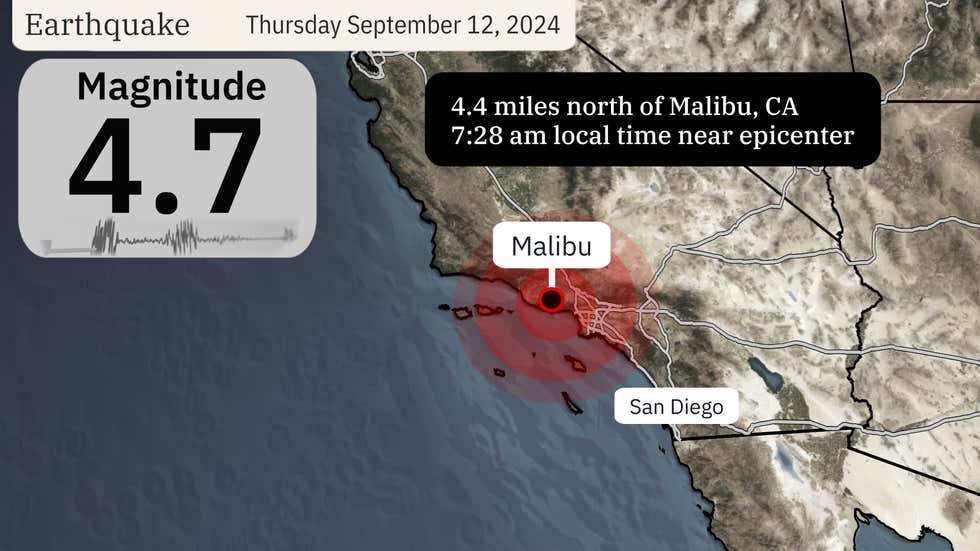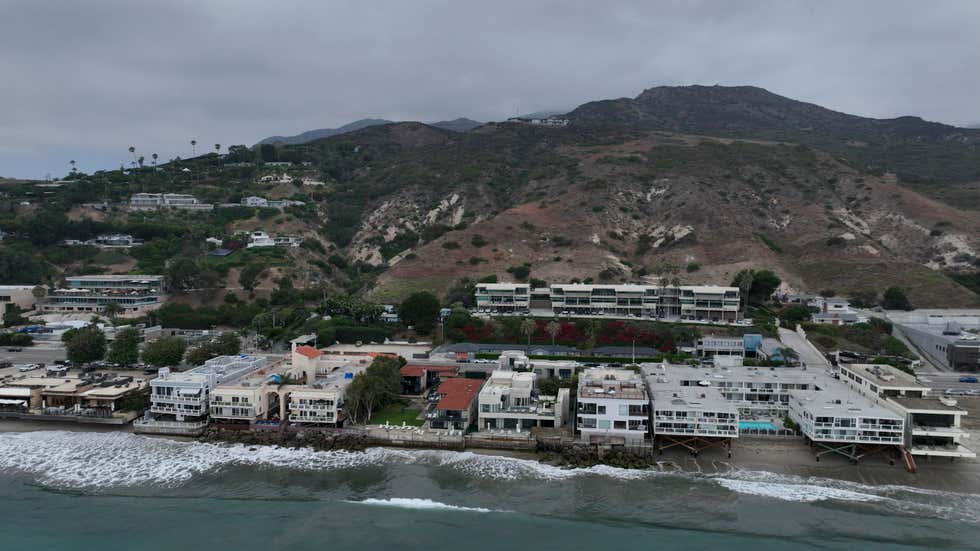A 4.7 magnitude earthquake shook the Los Angeles area early Thursday morning, shaking the city from Malibu to Santa Monica and even further inland.
According to the U.S. Geological Survey (USGS), the quake’s epicenter was about 4.5 miles north of Malibu, close to the Pacific coast. Residents across the region reported feeling the tremor, with some being startled awake by the sudden jolt.

Epicenter and Immediate Impact
The earthquake struck at 7:28 a.m. local time, causing boulders to fall onto Malibu Canyon Road. Though no major injuries or structural damage were reported, the intensity of the earthquake was enough to rattle homes and disrupt morning routines. The iconic Santa Monica Pier, a Los Angeles landmark built in 1909, could be seen shaking on a live stream for several seconds, according to the Associated Press.
EARTHQUAKE LIVE ON OUR SHOW.
Holy cow that was my first earthquake I’ve ever experienced. @TheFacilityFS1 pic.twitter.com/g0BiRPhZXv
— Chase Daniel (@ChaseDaniel) September 12, 2024
The USGS initially reported the quake as a magnitude 5.1, but later downgraded it to 4.7. It struck about 7 miles beneath the Earth’s surface, which likely helped prevent more serious damage. Despite the downgrade, the earthquake still caused anxiety, especially with the lingering threat of aftershocks in the days that followed.
Residents Share Their Experiences
Residents in areas far beyond Malibu felt the earthquake’s effects. People in Orange County shared reports of their homes shaking and items falling from shelves. Celebrities such as Paris Hilton and Khloe Kardashian took to social media to share their experiences, recounting their surprise at the tremors. Kathy Shapiro Wexler, a tourist visiting from Memphis, Tennessee, felt her hotel shake while in Long Beach. She described the sensation:

“It started out small but then it gradually became pretty apparent it was an earthquake. The building shook for about 10-15 seconds.”
Many residents in surrounding areas echoed similar experiences. While no serious damage was reported, the quake was enough to remind Californians of the ever-present seismic activity in the region.
The Risk of Aftershocks
Experts from the USGS warned of the possibility of aftershocks, which are typical following an earthquake of this magnitude. Though smaller in intensity, these secondary quakes can still pose risks, particularly if they occur near infrastructure or in densely populated areas. Authorities encouraged residents to remain cautious and to have emergency kits ready, as aftershocks can happen hours, days, or even weeks after the main event.
For those unfamiliar with earthquake preparedness, the Federal Emergency Management Agency (FEMA) provides valuable resources on how to stay safe during and after an earthquake. From securing heavy furniture to knowing evacuation routes, proper planning can make a significant difference in a seismic event.
Earthquake Preparedness in California
California is no stranger to earthquakes, and the state’s proximity to the San Andreas Fault makes seismic activity a regular concern. Thursday’s tremor is a reminder of how crucial earthquake preparedness is for those living in the region. The California Earthquake Authority (CEA) offers tips on how residents can better protect themselves and their homes, including securing furniture, retrofitting buildings, and maintaining an emergency supply kit.

Emergency preparedness in California often involves considering the worst-case scenario. Homeowners are encouraged to invest in earthquake insurance and make sure their homes comply with modern building standards, which are designed to withstand significant seismic forces.
Earthquake Occurs Amid Heatwave and Wildfires
The timing of this earthquake comes at an already challenging period for Southern California. A scorching heatwave has gripped the region, with temperatures soaring into the triple digits. In addition, three massive wildfires are raging east of Los Angeles, compounding the stress for residents and emergency responders alike. Firefighters have been working around the clock to contain the blazes, which have already scorched thousands of acres.
The combined forces of heat, fire, and now seismic activity are testing the resilience of Southern Californians. While Thursday’s earthquake did not exacerbate the fires, the tremors added to the growing list of environmental challenges the region is facing.
California’s Seismic Future
While Thursday’s earthquake served as a reminder of the power lurking beneath the Earth’s surface, experts say the state must remain vigilant for larger seismic events. The San Andreas Fault, which runs through much of California, has the potential to generate a massive earthquake in the future. Known as the “Big One,” such an earthquake could cause widespread destruction across the region.
Though there is no way to predict exactly when the next major earthquake will strike, scientists and government agencies are constantly working to improve seismic monitoring systems. Early-warning systems like ShakeAlert have already been implemented across California, providing residents with a few crucial seconds of warning before the shaking begins. These seconds can make a world of difference when it comes to taking cover or shutting down utilities to prevent further damage.
The 4.7 magnitude earthquake near Malibu was a stark reminder of California’s ongoing vulnerability to seismic activity. While this particular event did not result in significant damage or loss of life, it underscores the importance of earthquake preparedness for all residents of the region.
As the risk of aftershocks looms and the challenges of wildfires and extreme heat persist, Southern California’s resilience continues to be tested. Preparedness and vigilance are the keys to weathering such natural disasters and protecting lives and property in the future.
FAQs
What was the magnitude of the earthquake near Malibu?
The earthquake near Malibu had a magnitude of 4.7, though it was initially recorded as 5.1.
Where was the epicenter of the Malibu earthquake?
The earthquake’s epicenter was about 4.5 miles north of Malibu, close to the Pacific coastline.
Were there any injuries reported after the Malibu earthquake?
No major injuries or structural damage were reported following the earthquake.
Did aftershocks occur after the main earthquake?
Yes, several aftershocks were reported, and the likelihood of more is expected in the coming days.
What should residents do to prepare for future earthquakes?
Residents are advised to secure heavy furniture, create an emergency kit, and follow the guidance provided by organizations like FEMA and the California Earthquake Authority.
Are earthquakes common in the Malibu area?
Yes, California frequently experiences earthquakes due to its location on the San Andreas Fault. Smaller quakes are quite common, though larger events, like the 4.7 magnitude quake, draw more attention.
Suggested for Further Reading
- Santa Monica Pier Official Site
- California Earthquake Authority Resources
- ShakeAlert Early Warning System
By staying informed and prepared, residents can better protect themselves and their homes from the risks of seismic activity in California.
Thank You for Visiting our website mhnrc.org. If you liked the article, then share it with others.


